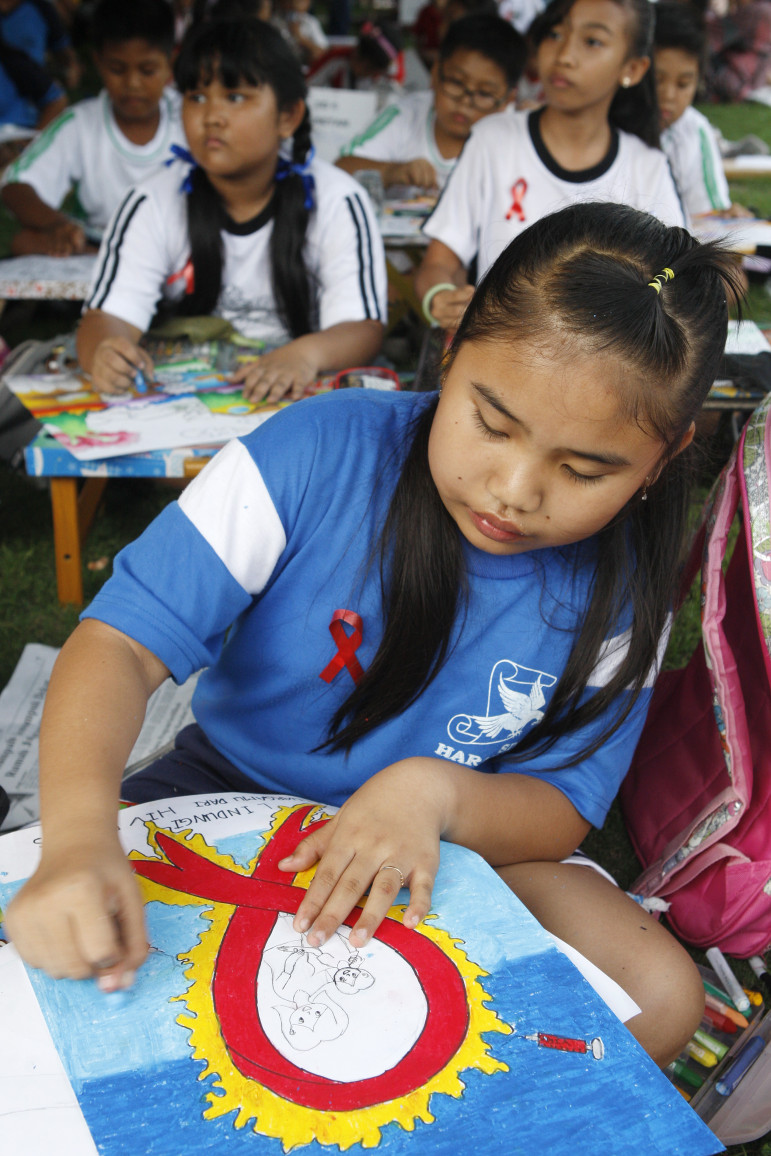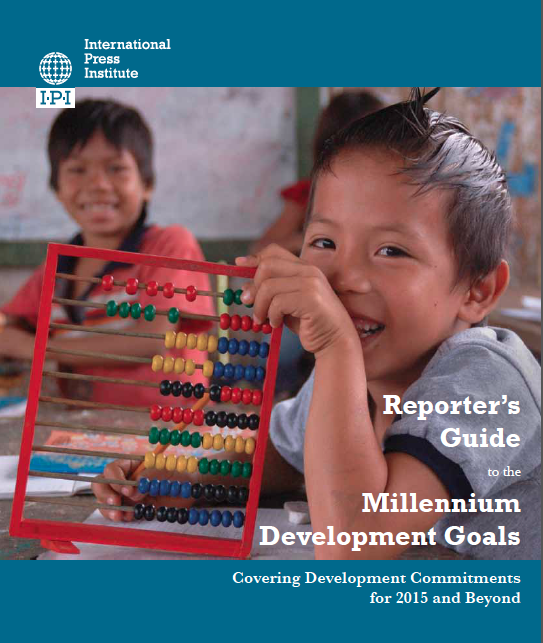

Two Million Dead in 2013: The HIV/AIDS Story Today
 Part 9 of a series GIJN is excerpting from the Reporter’s Guide to the Millennium Development Goals: Covering Development Commitments for 2015 and Beyond, published by the International Press Institute.
Part 9 of a series GIJN is excerpting from the Reporter’s Guide to the Millennium Development Goals: Covering Development Commitments for 2015 and Beyond, published by the International Press Institute.

Indonesia, in Dec. 2012. According to UN reports, HIV infections in Indonesia increased by more than 25% between 2001 and 2011. EPA/Made Nagi.
When a story on a particular topic is told over and over again, it leads to what is known as media fatigue—a situation where journalists and editors find the topic no longer newsworthy.
However, the worst is when audiences become fatigued—when general readers are fed up with the subject as well. This problem is one that bedevils HIV/AIDS reporting, despite the fact that many people—especially the affected and the infected—still want to learn more. Unlike what happened in the 1990s, when most editors wanted to have emotion-laden articles on HIV/AIDS, the 21st century is different. Editors are reluctant to approve such stories on HIV/AIDS unless they are convinced that there is something completely new in the article.
So, does this mean that HIV/AIDS is a tired story? It certainly should not be: in the year 2013 alone, close to 2 million people will lose their lives from the disease worldwide. Another 33 million will have to face the difficulties of living with AIDS. This story is one that must be told at all costs.
What follows are some ways journalists can ensure that this important issue does not go unreported.
Give Your Story a Human Face
The most boring way of telling a story about HIV/AIDS is when journalists peg their reports on statistics without breathing life into the numbers. Indeed, perhaps the lack of real-life is one of the reasons why editors are getting fatigued with the subject.
That is not to say that numbers are not important—in AIDS reporting, numbers can still help to impress upon the reader the seriousness and scale of the situation; however, to make them more immediate, these figures should be reported alongside the human faces of HIV/AIDS patients. Allowing people to tell their stories through the journalist is critical to supplement or explain the lifeless figures.
That said, it is clear that the human dimension of this particular story has changed over time. In the 1990s, a good HIV story would be told through a picture of a skeletal patient gasping for a last breath. This picture worked wonders as an emotional appeal to donors and as a fear-based strategy for behavioural change.
In 2013, such a photograph cannot tell the whole story anymore. With the development of anti-retroviral drugs, and the supplementation of correct nutritional foods, a person living with AIDS may appear healthier than many people living without the virus. The fear-based strategy no longer applies, which has completely changed the way we report on the disease.
Perhaps the abrupt change of the “HIV image” from “bad” to “good” might have influenced a number of journalists who no longer see the virus as newsworthy. According to experience, bad things easily make news. But if something looks good, then a journalist must work extra hard to convince the editor that it is important to cover.
Stay Up-to-Date on the Science
Journalists who report on HIV/AIDS should pay close attention to new research findings, resistance to anti-retroviral drugs, drug stock-outs, proliferation of counterfeit and substandard drugs, and most importantly, the figures. These aspects, while always important, can be made more interesting for the reader if they are told from a first-hand source or from someone with real-life experience.
Don’t Accept the Official Version
No matter what the approach, journalists must maintain a careful and analytical approach to reporting. Following the emotional appeal that was used in the advent of HIV/AIDS, hundreds if not thousands of organizations were formed with the aim of scaling down infections, reducing stigma, and providing care to patients. While most of these are genuine, some are out to make money and may try to take advantage of journalists in order to generate increased funds for themselves.
Many cases have apparently been stage-managed in order to trick unsuspecting journalists into write appealing stories. Some years ago, there was a scenario in Kenya in which inaccurate figures of HIV prevalence were circulated following a study, and then used as a point of reference for a long period of time afterward. But after a 2006 review, the figures were determined to be much lower than had been reported in the earlier findings. At that point, some officials told the media that the government and its partners had “worked hard” to reduce the prevalence.
This agitated one of Kenya’s senior science writers, who published an article in the Daily Nation headlined “Numbers Don’t Lie…Do They?”. In the piece, he gave a scenario of a road accident in which it is first erroneously announced that more than 20 people had died. After some time, the figure is revised, and the actual number of confirmed deaths becomes five. The writer asked: Should the minister for transport take pride and convene a press conference to announce that the government has worked hard to reduce the accident death toll on that day from 20 to five?
Before his article came out, several other journalists had already reported on the government’s “success” in reducing HIV prevalence. Without using a finer lens to read between the lines, those journalists simply repeated information given by a source.
Do Your Homework
This means that despite the fact that every journalist needs to have faith in his sources, each assertion by a source given must be treated cautiously before it should be considered a fact. The best way of doing this is by researching the topic before meeting the interviewee. This background information is critical because it can guide a journalist’s questions and clarify complex issues related to HIV/AIDS.
Journalists should also be sure to get the contact information—especially mobile telephone numbers—of the source, as this makes it easier to go back to the interviewee with clarifications and follow-up questions. Additionally, journalists should seek to talk to people with divergent views on the subject in order to balance the article.
If the subject is heavily scientific, the journalist can seek to send a draft to an expert or trusted source before submitting it to an editor. The journalist, though, must ensure that the expert or source checks only for the accuracy of scientific information; the review should not involve the changing of facts or the story line, or the addition of further viewpoints.
Keep the Audience in Mind
Remember that you are writing for the general public, not medical experts. Simplicity and accuracy can both help make an HIV/AIDS story more interesting and appealing. This means that the writer must explain all jargon—however simple certain words might appear. Acronyms should be explained in full the first time they appear in a story, regardless of how obvious they may seem.
Follow Basic Journalism Rules
Above all, it is important to keep in mind basic journalistic skills. Determine what content is more or less important to the story, and keep track of events, so that information flows chronologically. Do not keep readers in suspense for too long as many may not be willing to wait to read to the end. Think about the audience and find out their preferences. Determine what is interesting to them—not just what is interesting to you. Keep things simple and accurate. In the case of a HIV/AIDS story, avoid incriminating phrases. Make the right choice of photographs to avoid stigmatising both the audience and the people in the image (and be sure to seek permission before taking such photographs).
Not Every Story Must Be Told
And, even before considering all of these tips, the journalist needs to gauge the potential impact of the story on society. Certain stories may be better left untold. To given an example from another subject matter, a story about a drug trafficker can be powerful depending on the angle. But profiling the success story of a trafficker who earned millions through the trade might not be in the best interest of society. Rags to riches stories are easy ways to sell to consumers, but journalists should always follow fundamental ethical principles.
All of these tips taken together can help to combat reader and editor fatigue surrounding HIV/AIDS stories, and, critically, to ensure that the virus and its victims remain in the spotlight.
Isaiah Esipisu is a Kenyan journalist who received his professional training at the Kenya Institute of Mass Communication. He started writing newspaper articles in 1999 while still at university. Since then, he has worked as a freelance science journalist focusing on the environment, health, agriculture, and technology, publishing in such outlets as Reuters AlertNet, Inter Press Service, The East African, The Standard, the Kenya News Agency, and AgroLink. Together with five other journalists, Esipisu published a photography book entitled The Kindest Cut, which highlighted male circumcision as a major preventative measure against HIV infection.
Excerpted from Reporter’s Guide to the Millennium Development Goals: Covering Development Commitments for 2015 and Beyond. Agreed to in 2000, the UN Millennium Goals comprise an ambitious agenda to improve quality of life around the world, focusing on such issues as poverty, gender equality, and education. This unique manual, available in four languages, offers journalists practical tips on covering these critical areas as we near the 15th anniversary of the goals. Twenty-one journalists across six continents contributed to the report, including several active in GIJN. We are grateful to the publisher, the International Press Institute, for permission to publish the series, and to the European Press Photo Agency and EFE Agency for permission to publish the accompanying photos.










